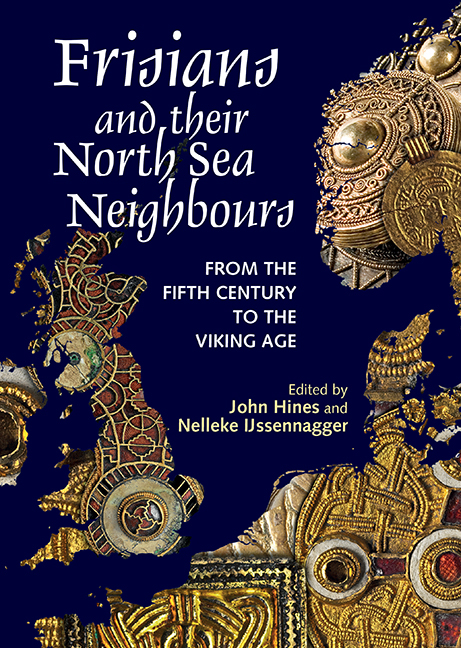Book contents
- Frontmatter
- Contents
- List of Figures
- List of Tables
- Preface
- Acknowledgements
- Linguistic Conventions and Abbreviations
- Abstracts
- Introduction: Frisians – Who, When, Where, Why?
- 1 Palaeogeography and People: Historical Frisians in an archaeological light
- 2 The Anglo-Frisian Question
- 3 Frisian between the Roman and the Early Medieval Periods: Language contact, Celts and Romans
- 4 ‘All quiet on the Western Front?’ The Western Netherlands and the ‘North Sea Culture’ in the Migration Period
- 5 Power and Identity in the Southern North Sea Area: The Migration and Merovingian Periods
- 6 How ‘English’ is the Early Frisian Runic Corpus? The evidence of sounds and forms
- 7 The Geography and Dialects of Old Saxon: River-basin communication networks and the distributional patterns of North Sea Germanic features in Old Saxon
- 8 Between Sievern and Gudendorf: Enclosed sites in the north-western Elbe–Weser triangle and their significance in respect of society, communication and migration during the Roman Iron Age and Migration Period
- 9 Cultural Convergence in a Maritime Context: Language and material culture as parallel phenomena in the early-medieval southern North Sea region
- 10 The Kingdom of East Anglia, Frisia and Continental Connections, c. ad 600–900
- 11 A Comparison of the Injury Tariffs in the Early Kentish and the Frisian Law Codes
- 12 Cultural Contacts between the Western Baltic, the North Sea Region and Scandinavia: Attributing runic finds to runic traditions and corpora of the Early Viking Age
- Index
8 - Between Sievern and Gudendorf: Enclosed sites in the north-western Elbe–Weser triangle and their significance in respect of society, communication and migration during the Roman Iron Age and Migration Period
Published online by Cambridge University Press: 25 August 2018
- Frontmatter
- Contents
- List of Figures
- List of Tables
- Preface
- Acknowledgements
- Linguistic Conventions and Abbreviations
- Abstracts
- Introduction: Frisians – Who, When, Where, Why?
- 1 Palaeogeography and People: Historical Frisians in an archaeological light
- 2 The Anglo-Frisian Question
- 3 Frisian between the Roman and the Early Medieval Periods: Language contact, Celts and Romans
- 4 ‘All quiet on the Western Front?’ The Western Netherlands and the ‘North Sea Culture’ in the Migration Period
- 5 Power and Identity in the Southern North Sea Area: The Migration and Merovingian Periods
- 6 How ‘English’ is the Early Frisian Runic Corpus? The evidence of sounds and forms
- 7 The Geography and Dialects of Old Saxon: River-basin communication networks and the distributional patterns of North Sea Germanic features in Old Saxon
- 8 Between Sievern and Gudendorf: Enclosed sites in the north-western Elbe–Weser triangle and their significance in respect of society, communication and migration during the Roman Iron Age and Migration Period
- 9 Cultural Convergence in a Maritime Context: Language and material culture as parallel phenomena in the early-medieval southern North Sea region
- 10 The Kingdom of East Anglia, Frisia and Continental Connections, c. ad 600–900
- 11 A Comparison of the Injury Tariffs in the Early Kentish and the Frisian Law Codes
- 12 Cultural Contacts between the Western Baltic, the North Sea Region and Scandinavia: Attributing runic finds to runic traditions and corpora of the Early Viking Age
- Index
Summary
Even today, the waterways of the seas and rivers provide important signposts to the infrastructure of world-wide trade, transport and communication. Likewise in the 1st millennium ad, the maritime routes along the coasts, together with the rivers and streams and the almost undefined land routes (Bischop 2000, 27) that marked the landscapes of northern Europe through bogs and wet valley bottoms provided the practical foundations for regional and trans-regional communication and the transportation of goods (Jöns 2009, 390–1; Nørgaard Jørgensen 2003, 195; for an overview, Siegmüller 2011; Siegmüller and Jöns 2012, 575–6; 2011, 98). Together with the land routes and the inland waters that connected these to areas lying further inland, they formed a regular network of communication routes (Ellmers 2005, 74–5; 1999, 597; Jöns 2009, 389).
Archaeologically, the importance of the waterways in goods exchange can be demonstrated through the distribution of foreign goods (cf. Brather 1996, 46). For the first half of the 1st millennium ad this can be seen particularly through objects of provincial Roman origin in the areas located north of the limes (e.g. Eggers 1951; Lund Hansen 1987; Erdrich 2001; 2002). The mapping of these objects reveals the greatest concentrations in the vicinity of major watercourses and by the coasts (most recently Siegmüller and Jöns 2011, 98; Jöns 2009, 389–91).
Research into the archaeologically tangible basic structure of regional and transregional communication, which has been pursued particularly vigorously around the Baltic area during the past twenty years, has been able to show that, during the whole of the 1st millennium, control of the land routes and waterways can be seen to have had great social significance. In this light, attention has been paid in many places to the establishment of landing places (Ulriksen 1998; 2004), trans-shipment sites and beach markets (Thomsen et al. 1993), which served as portals between long-distance and internal transport. The significance of the communication and transport routes and of control of these links can also be recognized in the relatively frequently discovered construction of ramparts, canals, sea-barriers and blockades in rivers and lakes in southern Scandinavia (see Nørgaard Jørgensen 2001; 2003).
- Type
- Chapter
- Information
- Frisians and their North Sea NeighboursFrom the Fifth Century to the Viking Age, pp. 149 - 172Publisher: Boydell & BrewerPrint publication year: 2017



